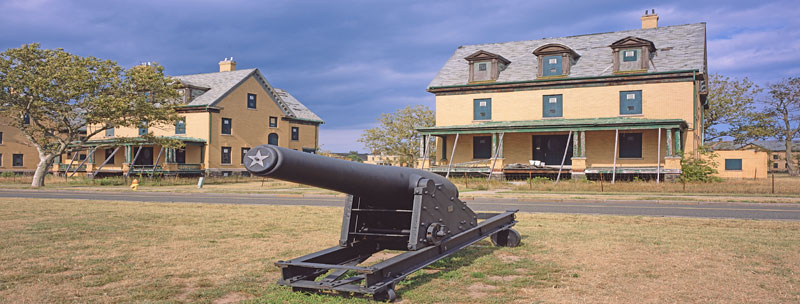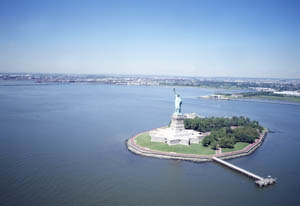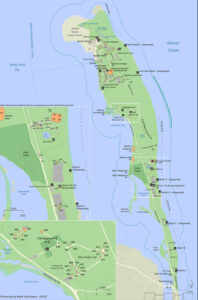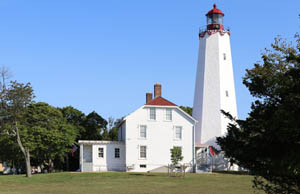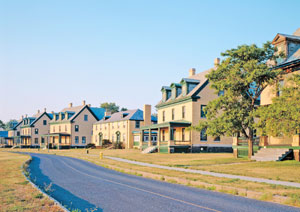Fort Hancock is a former United States Army fort at Sandy Hook, New Jersey. The coastal artillery base defended the Atlantic coast and the entrance to New York Harbor, with its first gun batteries operational in 1896. The fort served until 1950 as part of the Harbor Defenses of New York and predecessor organizations.
From the beginning, ships entering New York Harbor needed a deep channel. Until the 1900s, that meant sailing next to the shore of Sandy Hook. Sandy Hook’s geographic location made it a critical defense site for the harbor area. In 1764, the Colony of New York built Sandy Hook Light to assist navigation. Because the lighthouse helped ships sail safely to New York Harbor, the structure has always had inherent military value. The Sandy Hook Light is the oldest working lighthouse in the United States.
A military presence quickly followed the lighthouse’s construction and has remained more or less since the American Revolution. Forts have occupied Sandy Hook during times of war, with each fort representing a new defense system reflecting technological weapons, construction, and tactics advances. Enemy warships had to sail well within the cannon range of forts.
In early 1776, the British quickly captured the Sandy Hook peninsula. In June 1776, Continental Army Lieutenant Colonel Benjamin Tupper led his artillery to destroy the lighthouse “but found the walls so firm I could make no Impression.” Unlike most of New Jersey, the Sandy Hook Lighthouse and New York City remained in British and Loyalist hands until the war ended in 1783. Loyalists guarded the Light for the remainder of the War, using the Hook to stage raids on patriot-held areas in New Jersey. The cannonball-dented walls remained visible until repairs occurred just before the Civil War, when the walls were considerably thickened.
In 1806, landowner Richard Hartshorne transferred most of northern Sandy Hook to the Federal Government for military use. By 1817, all final transfers of land ownership were complete.
During the War of 1812, a wooden fortification named Fort Gates, an example of what is now called the Second System of Defense was constructed in 1813. The lighthouse was armed with a cannon. After the war, recommendations were made to construct a sizeable permanent fortification at the end of the Hook. Still, it wasn’t until just before the Civil War began that work began.
The Sandy Hook area was first fortified as part of the third system of U.S. fortifications, with work beginning in 1857. Over the next three years, a large pier was constructed to receive new building supplies and materials, and the fort was laid out. In 1859, the U.S. Army began construction. It also served as a camp for the 10th New York Volunteer Infantry.
After the Civil War, it was determined that masonry forts were vulnerable to rifled guns, and funding for their construction was cut off in 1867. Though the fort was serviceable, it was largely incomplete.
In 1874, the federal government chose Sandy Hook for the United States Army’s first official proving ground for testing weapons and artillery. Everything from small arms to giant 16-inch caliber cannons were test-fired at targets on the Hook’s oceanside beaches and dunes. This was operated by the Ordnance Department and was run separately from Fort Hancock.
In 1885, most of what remained of the fort was cannibalized to build the Sandy Hook Proving Ground, the new Fort Hancock, and supporting structures such as a seawall. A small portion of one wall remains in place with four cannon ports.
Starting in 1890, the Army constructed the first of many concrete gun batteries of the Endicott era. Next were Taft Defenses, which included changes to existing fortifications and the addition of 12-inch barbette guns.
On October 30, 1895, the United States Army designated the fortifications and installations on Sandy Hook, Fort Hancock, in honor of Major General Winfield Scott Hancock. General Hancock was a gallant fighter for the Union during the Civil War and the unsuccessful opponent of James A. Garfield in the presidential election of 1880. Two tower forts were initially proposed, but a much larger single fort was decided on instead. The initial design of the fort was by then-Captain Robert E. Lee of the Army Corps of Engineers. The fort was designed as a five-bastion irregular pentagon, with two tiers of cannon totaling 173 guns on three seacoast fronts, with another 39 guns covering the landward approaches. As was common in Third System forts in the Northeast, it was built primarily of granite.
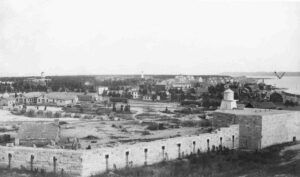
Fort Hancock, New Jersey. The Army took down most of the surviving parts of this structure after World War II.
Never a traditional walled fortress, Fort Hancock was a community of many permanent brick buildings that housed the soldiers who manned the fort’s concrete gun batteries built to protect New York Harbor. Fort Hancock’s first 34 buildings were built in 1898 and 1899. The long row of Officers’ Quarters is an outstanding feature of the post. Each of the 18 Georgian Revival-style homes housed one officer and family. When constructed, the lieutenant’s homes (Buildings 1-8 and 16-18) cost about $8,200 each; the Captains’ houses (9-11 and 13-15), about $12,000 each; and the more prominent commanding officer’s house, $19,000. The Fort Hancock Museum (Building 28) was constructed in 1899 and originally served as the post guardhouse. Other fort buildings supplied food, clothing, protection, and additional support services.
Fort Hancock’s proving ground weapons helped make the army a powerful military force during the Spanish-American War and World War I, conflicts that made the United States a world power.
From 1900 through World War II, additional brick and wooden buildings and tent cities were added to accommodate more soldiers. During peacetime, the fort’s garrison numbered between 400 and 800 officers and enlisted men.
In 1901, coast artillery companies were created by redesignating the heavy artillery companies that previously garrisoned forts, and in 1907, the United States Army Coast Artillery Corps was established to operate the country’s new defenses.
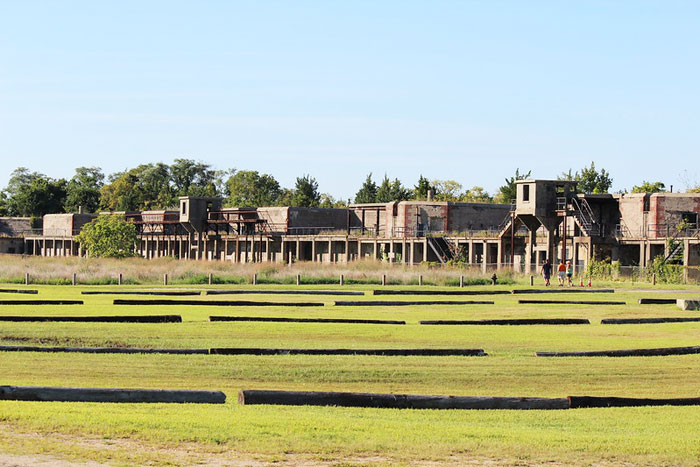
Nine gun battery at Fort Hancock, New Jersey by Shinya Suzuki/Flickr
Fort Hancock’s defenses waxed and waned with the nation’s needs from the end of the Spanish-American War through World War II.
The firing range at Sandy Hook proved too short as guns became more powerful. In 1919, the proving ground operations were transferred to Aberdeen, Maryland.
The fort reached its peak population in 1945 when 18,000 men and women were stationed there.
Aircraft changed the style of warfare forever, and by the end of World War II, anti-aircraft guns had taken over the critical defensive role at Fort Hancock. The Cold War era brought a change from anti-aircraft guns to Nike Missiles that could intercept jet warplanes. These surface-to-air nuclear missiles were housed here between 1954 and 1974.
The fort was decommissioned on December 31, 1974. Fort Hancock was never attacked.
Since then, most of Fort Hancock has served the public as the Sandy Hook Unit of Gateway National Recreation Area. The remainder of the peninsula serves as U.S. Coast Guard Station Sandy Hook. A museum is managed as part of the Sandy Hook Unit of Gateway National Recreation Area.
A 20-inch Rodman gun (the biggest gun produced in the Civil War era), a 10-inch Rodman gun, several Nike missiles, and two rare 6-inch M1900 guns at Battery New Peck are displayed at the fort. Battery New Peck was the only gun battery at Fort Hancock that wasn’t salvaged for scrap after World War II, and these two guns are still retained on barbette carriages made in 1903.
Fort Hancock has one of the largest collections of preserved Endicott batteries anywhere, including various experimental batteries at the former proving ground. Many of the garrison buildings survive. However, only a small part of one wall of the third system fort, with four embrasures, remains.
Sandy Hook is the New Jersey Unit of Gateway National Recreation Area. The park is open daily from sunrise to sunset. Assistance is available at the ranger station, visitor center, or from any park ranger.
© Kathy Alexander/Legends of America, updated January 2024.

